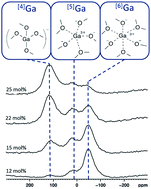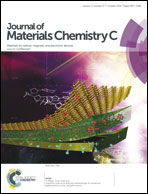Properties and structural investigation of gallophosphate glasses by 71Ga and 31P nuclear magnetic resonance and vibrational spectroscopies
Abstract
The structure and optical properties of new gallophosphate glasses in the pseudo-binary system xGa2O3 − (100 − x) NaPO3 (x = 0 to 30 mol%), have been investigated. The effect of the progressive addition of Ga2O3 on the local glass structure has been evaluated using Raman and infrared spectroscopies, and 71Ga and 31P magic angle spinning nuclear magnetic resonance (MAS NMR) spectroscopy. 71Ga MAS NMR spectra collected at ultrahigh magnetic field (21.1 T) and fast spinning rates (60 kHz) permit the quantification of gallium in 4-, 5- and 6-fold coordination as a function of the Ga2O3 concentration. At low concentrations of Ga2O3, high-coordinate gallium coordinates to oxygens associated with the phosphate chains, increasing the dimensionality and strengthening the glassy network. At moderate Ga loadings, tetrahedral Ga is incorporated into the phosphate chains, introducing additional branching sites which further enhances network connectivity. Higher Ga2O3 content results in the formation of Ga–O–Ga bonds, thereby inhibiting glass formation. 31P MAS NMR and Raman and infrared spectroscopies provide complementary information about the distribution and connectivity of the phosphate groups within the glass network, supporting a structural model which is correlated with the measured optical and thermal properties of the Ga2O3–NaPO3 glasses as a function of the Ga2O3 concentration.


 Please wait while we load your content...
Please wait while we load your content...